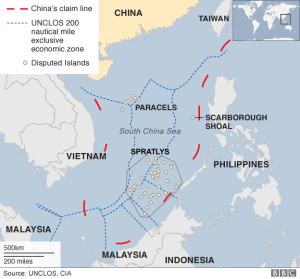
09/15/2025
Historical Background: The South China Sea Dispute
The South China Sea is a 3.5 million km² semi-enclosed sea bordered by China, the Philippines, Vietnam, Malaysia, Brunei, and Taiwan. It is one of the world’s busiest maritime routes, carrying about 30% of global trade and rich in oil, gas, and fisheries. The region is highly contested due to overlapping territorial claims, most notably China’s expansive “nine-dash line”, which conflicts with UNCLOS provisions and the rights of Southeast Asian nations. Beyond resources, the sea is a geopolitical flashpoint, where sovereignty, freedom of navigation, and international law collide.
The South China Sea is one of the most contested maritime spaces on the planet. Stretching from the coasts of China, Vietnam, and the Philippines to the waters of Malaysia, Brunei, and Taiwan, it covers around 3.5 million square kilometers. Its importance is both material and symbolic:
- Strategic shipping artery: Around 30% of global maritime trade—including energy flows from the Middle East to East Asia—passes through the region.
- Resource wealth: The sea holds vast reserves of hydrocarbons (estimated 11 billion barrels of oil and 190 trillion cubic feet of natural gas) and rich fishing grounds feeding millions.
- Geopolitical hotspot: Competing claims are based on history, maps, proximity, and interpretations of UNCLOS. China asserts the so-called “nine-dash line”, covering nearly the entire sea, while Southeast Asian states push back under international law.
The South China Sea has long been more than a maritime dispute. It is a testing ground for the global order: whether sovereignty is defined by raw power or by the rules-based system anchored in UNCLOS.
The Scarborough Reef Controversy
Scarborough Shoal (Huangyan Dao in Chinese), a small atoll northeast of the Spratly Islands, lies about 120 nautical miles west of Luzon in the Philippines. It is:
- Within the Philippines’ Exclusive Economic Zone (EEZ) under UNCLOS.
- Historically fished by Filipino, Chinese, and Vietnamese fishermen.
- Effectively controlled by China since 2012, after a naval standoff.
In September 2025, Beijing proposed to designate the area as a “marine nature reserve.” On the surface, such a move sounds like environmental protection. But Manila and Washington see it differently: a strategy to institutionalize Chinese control under the guise of conservation.
U.S. Secretary of State Marco Rubio dismissed the plan as “yet another coercive maneuver,” warning that the so-called reserve would block Filipino fishermen’s traditional rights and extend Beijing’s maritime dominance.
Legal Framework: UNCLOS and the 2016 Arbitration Ruling
The United Nations Convention on the Law of the Sea (UNCLOS), signed in 1982, provides the main legal framework:
- Coastal states have sovereign rights over resources within their 200-nautical-mile EEZ.
- Artificial islands or “historic rights” beyond EEZs are not recognized unless specifically negotiated.
- All states enjoy freedom of navigation and overflight in international waters.
In 2016, the Permanent Court of Arbitration (PCA) in The Hague ruled in favor of the Philippines, declaring that:
- China’s “nine-dash line” has no legal basis under UNCLOS.
- Scarborough Shoal is a traditional fishing ground, where China cannot legally exclude Filipino fishermen.
- Beijing’s artificial island building violated environmental obligations.
China rejected the ruling outright, calling it a “sham,” but the decision remains a cornerstone of the international legal position. For the U.S. and allies, Beijing’s 2025 reserve plan looks like a direct defiance of UNCLOS and the tribunal’s award.
Washington’s Position: Trump Redux in 2025
The return of Donald Trump to the White House in 2025 has sharpened U.S. rhetoric. Unlike his earlier term, where focus was on trade wars and naval patrols, his administration is now explicitly framing South China Sea disputes as core issues of international law.
By siding with the Philippines, Washington signals three things:
-
Alliance credibility: U.S. defense commitments to Manila under the Mutual Defense Treaty must be seen as reliable.
-
Freedom of navigation: Blocking Filipino fishermen sets a precedent that could extend to commercial shipping.
-
Broader deterrence: If Beijing succeeds here, similar strategies could be applied elsewhere, from the East China Sea to the Arctic.
Rubio’s strong language shows the U.S. strategy is not just about one shoal—it’s about defending the rules-based maritime order.
Beijing’s Strategy: Conservation as Control
Labeling Scarborough Reef a “nature reserve” is more than a matter of semantics—it is a calculated political move that fits neatly within Beijing’s wider playbook of lawfare and soft power. By presenting the measure as an environmental initiative, China makes its actions more palatable to international audiences, who may be less inclined to question restrictions when they are framed in the language of conservation and sustainability. What appears at first glance to be ecological oversight gradually becomes a tool of sovereignty, normalizing Chinese presence and jurisdiction in contested waters.
At the same time, the move allows Beijing to wage an information campaign, positioning itself as a champion of marine conservation even as it excludes neighboring states and restricts their access. This dual messaging enables China to consolidate authority under a cloak of environmental legitimacy. Critics are quick to point out that this tactic is not new. It echoes Beijing’s earlier approach of constructing artificial islands ostensibly for “research purposes,” which were later equipped with airstrips, radars, and military installations. The Scarborough reserve proposal, therefore, should be understood not as an isolated environmental policy but as part of a broader strategy of maritime control dressed in neutral, almost benevolent, terms.
Impact on Local Fishing Communities
For Filipino fishing communities, the Scarborough Shoal dispute is not an abstract geopolitical contest but an existential struggle. These waters sustain the livelihoods of tens of thousands of fishermen who have for generations relied on their rich fisheries for food and income. Any restriction, whether in the form of permits, outright bans, or tightened surveillance, directly threatens their survival. The consequences are immediate: families risk sliding into poverty, local economies shrink, and food insecurity becomes an everyday reality.
The risks are not only economic but also personal. Increased patrols and stricter enforcement mean that fishermen venturing into contested waters face harassment, intimidation, and even arrest. Boats have been seized, crews detained, and incidents of confrontation with Chinese coast guard vessels have left deep scars in local memory. These dangers transform what should be routine fishing trips into hazardous undertakings, fraught with the possibility of violence or legal entanglement.
While these human dimensions are often overshadowed by high-level discussions of sovereignty and international law, they remain central to Manila’s stance. For the Philippine government, protecting its fishermen is both a matter of sovereignty and of domestic political legitimacy. Allowing communities to be pushed aside by external power would not only undermine livelihoods but also erode national pride and trust in the state’s ability to defend its citizens’ rights at sea.
Broader Implications for Global Maritime Trade
The South China Sea is not just about reefs. It is the second-most critical maritime chokepoint after the Strait of Hormuz. If tensions escalate:
- Insurance premiums for vessels transiting could spike.
- Shipping routes may be diverted, adding time and cost.
- Naval presence (U.S., China, ASEAN) increases risk of accidents or miscalculation.
- Energy security for Japan, South Korea, and even Europe could be shaken.
For companies like Grimaldi Group, Maersk, or MSC, stability of sea lanes matters. Even if Grimaldi’s core operations are in Europe, disruptions in Asia reverberate globally through container availability, port congestion, and freight rates.
Comparisons with Other Maritime Disputes
The Scarborough case mirrors broader patterns:
- Arctic routes: Russia’s push to regulate the Northern Sea Route under “environmental” rules.
- Eastern Mediterranean: Turkey–Greece disputes over EEZs tied to hydrocarbon reserves.
- Persian Gulf: Designation of exclusion zones framed as “safety” or “environmental control.”
Each shows how UNCLOS ambiguities and power politics intersect, leaving smaller states vulnerable and global trade exposed.
–
Future Outlook: Scenarios and Predictions
Looking ahead, several trajectories are possible:
-
Escalation
- China enforces the reserve with coast guard patrols.
- Filipino fishermen are arrested or expelled.
- U.S. Navy escorts Philippine vessels, risking standoffs.
-
Compromise
- Beijing allows “regulated fishing” with permits, softening tensions while keeping control.
- ASEAN pushes for a Code of Conduct that includes environmental clauses.
-
Status Quo
- Reserve is declared but weakly enforced.
- China maintains presence; Manila and Washington continue protests.
Prediction: Given China’s track record, the most likely scenario is gradual enforcement: increased controls, limited Filipino access, and a slow normalization of Chinese authority. This risks turning the South China Sea into a patchwork of controlled enclaves, eroding UNCLOS norms.
Conclusion: Why This Matters for Shipping and Global Order
The dispute over Scarborough Reef is far more than a quarrel over fishing rights; it represents a litmus test for the future of maritime governance. If Beijing is able to successfully reframe territorial claims under the guise of conservation, the precedent could spread globally, encouraging other powers to disguise strategic control as environmental stewardship. At the same time, if the rulings of UNCLOS continue to go unenforced, the credibility of international maritime law itself will begin to erode, weakening one of the few universal frameworks governing the oceans.
For the global shipping industry, including companies such as the Grimaldi Group, the consequences of instability are often hidden but substantial. Rising freight rates, the need for rerouting, and higher insurance premiums eventually filter down to cargo owners and, ultimately, to consumers worldwide. In this sense, the South China Sea is not just a regional concern but a global one.
It embodies the complex intersection of environment, law, sovereignty, and trade, where every move—whether labeled “green,” “technical,” or “peaceful”—carries political weight. In the high-stakes world of global shipping, politics at sea is never detached from economics at port, and the outcome of disputes like Scarborough will shape the future of maritime order for decades to come.



This article effectively exposes Chinas deceptive use of environmental protection to solidify control over disputed waters, highlighting the serious implications for maritime law and local communities. The detailed legal and geopolitical analysis is compelling and worrying.